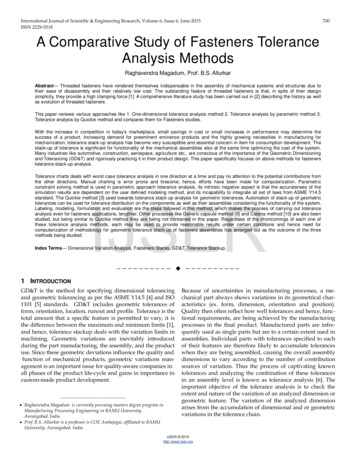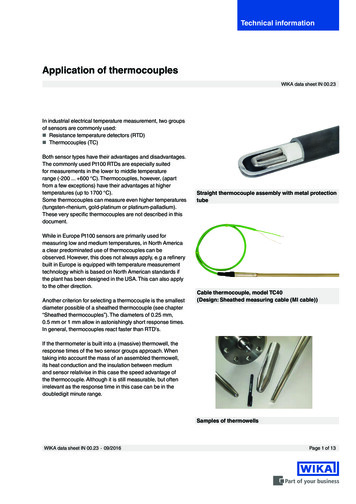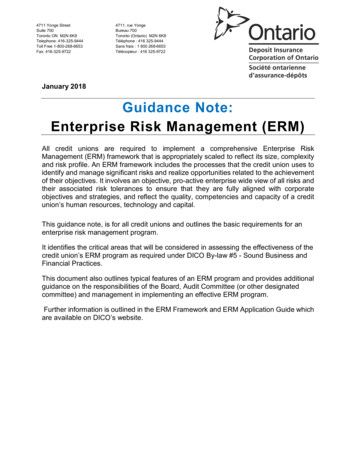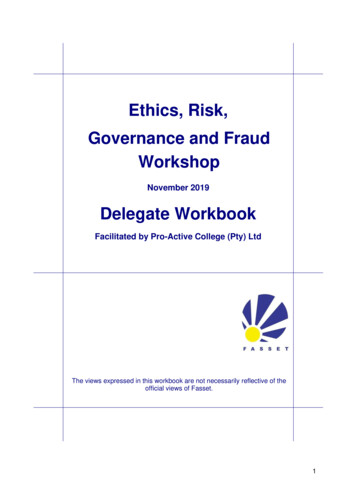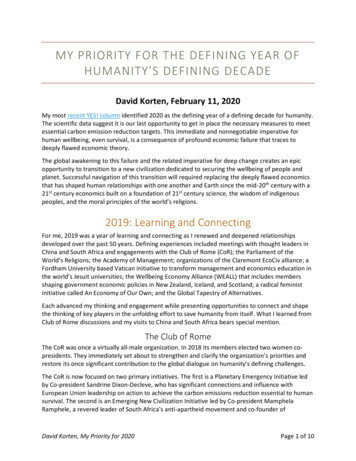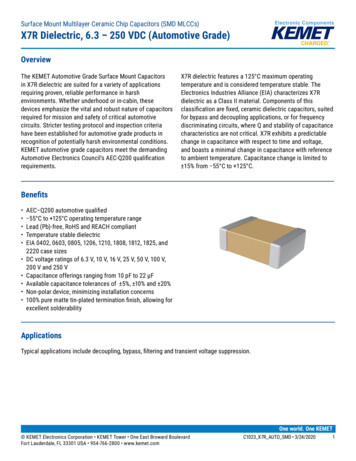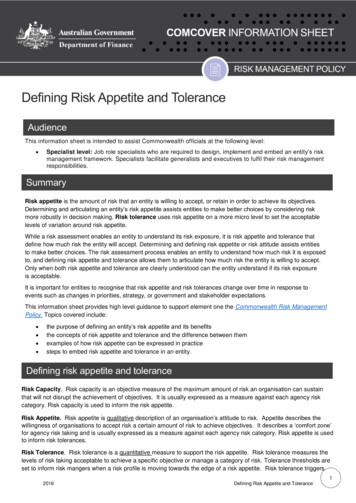
Transcription
Defining Risk Appetite and ToleranceAudienceThis information sheet is intended to assist Commonwealth officials at the following level: Specialist level: Job role specialists who are required to design, implement and embed an entity’s riskmanagement framework. Specialists facilitate generalists and executives to fulfil their risk managementresponsibilities.SummaryRisk appetite is the amount of risk that an entity is willing to accept, or retain in order to achieve its objectives.Determining and articulating an entity’s risk appetite assists entities to make better choices by considering riskmore robustly in decision making. Risk tolerance uses risk appetite on a more micro level to set the acceptablelevels of variation around risk appetite.While a risk assessment enables an entity to understand its risk exposure, it is risk appetite and tolerance thatdefine how much risk the entity will accept. Determining and defining risk appetite or risk attitude assists entitiesto make better choices. The risk assessment process enables an entity to understand how much risk it is exposedto, and defining risk appetite and tolerance allows them to articulate how much risk the entity is willing to accept.Only when both risk appetite and tolerance are clearly understood can the entity understand if its risk exposureis acceptable.It is important for entities to recognise that risk appetite and risk tolerances change over time in response toevents such as changes in priorities, strategy, or government and stakeholder expectations.This information sheet provides high level guidance to support element one the Commonwealth Risk ManagementPolicy. Topics covered include: the purpose of defining an entity’s risk appetite and its benefitsthe concepts of risk appetite and tolerance and the difference between themexamples of how risk appetite can be expressed in practicesteps to embed risk appetite and tolerance in an entity.Defining risk appetite and toleranceRisk Capacity. Risk capacity is an objective measure of the maximum amount of risk an organisation can sustainthat will not disrupt the achievement of objectives. It is usually expressed as a measure against each agency riskcategory. Risk capacity is used to inform the risk appetite.Risk Appetite. Risk appetite is qualitative description of an organisation’s attitude to risk. Appetite describes thewillingness of organisations to accept risk a certain amount of risk to achieve objectives. It describes a ‘comfort zone’for agency risk taking and is usually expressed as a measure against each agency risk category. Risk appetite is usedto inform risk tolerances.Risk Tolerance. Risk tolerance is a quantitative measure to support the risk appetite. Risk tolerance measures thelevels of risk taking acceptable to achieve a specific objective or manage a category of risk. Tolerance thresholds areset to inform risk mangers when a risk profile is moving towards the edge of a risk appetite. Risk tolerance triggers12016Defining Risk Appetite and Tolerance
and limits are designed to keep the organisation within the risk appetite and to provide a safety margin to prevent aprogram from reaching or exceeding its risk capacity.Distinguishing between risk appetite and risk toleranceBoth risk appetite and risk tolerance set boundaries to define how much risk an entity is prepared to accept. However,it can be difficult to distinguish between the two; a risk appetite statement is a higher level measure that broadlyconsiders the levels of risk management deemed acceptable, to contrast risk tolerances are narrower and set theacceptable levels of variation around objectives.An example of a risk appetite statement would be an entity saying that that it will not accept risks that would causesignificant injury to employees. In extending this to a risk tolerance statement, an entity may declare that it will onlyallow employees to engage in high risk physical activity for one hour a day.Risk tolerance represents the practical application of risk appetite and is typically aligned to categories of risk suchas strategy, financial, people or reputation. While risk appetite usually involves qualitative statements, risk toleranceoperationalises the statements by using quantitative measures where possible, to better enable monitoring and reviewof the risk.What are the benefits of defining risk appetite and tolerance? Support conscious and informed risk taking - By defining how much risk an entity is willing to accept, officialscan make informed choices when talking about new programs, efficiency, and decision making. Risk appetiteprovides structure to this conversation and explicitly communicates what is acceptable.Promote more consistent risk management - An entity’s risk appetite communicates broadly how much riskis acceptable, or indeed desirable, enabling more consistent risk taking throughout the entity.Guiding risk decision making and seizing opportunities - Risk appetite statements can increase thetransparency of the decision making process by enabling officials tobetter understand the entity’s position on risk. It allows officials to better identify opportunities for further risktaking or identify areas where unacceptable risk taking is occurring.Structuring the executive conversation on risk taking - Senior executives can often find it challenging toarticulate appropriate levels of risk taking. A structured approach to articulate risk appetite facilitates thisprocess and encourages useful debate on what constitutes as a desirable, acceptable or unacceptable risk.Calibrating the entity risk assessment process - Most entities use likelihood and consequence tables and‘heatmap’ matrices to assess the severity of individual risks. In turn, these risk severity ratings typicallydetermine the acceptability of a risk or define the treatment approach to be followed. If these risks are notcalibrated, the resultant actions may be skewed either too lightly (e.g. no action required) or result in anover-controlled risk response.Narrative statements - A carefully developed risk appetite can support the development of these narrativestatements often used to describe different levels of risk. Indeed, for entities with otherwise mature existingrisk frameworks, these can form a starting point for developing risk appetite.Risk appetite statementsRisk appetite and tolerance form the key components of a risk appetite statement. Although the specific content willvary in line with the needs of individual entities, a risk appetite statement is typically a short document containing: a clear statement of endorsement from the senior executive, reinforcing the importance of informed risk taking a definition of what the risk appetite statement is and how it is to be used a high level statement of the entity’s risk appetite, including its overall attitude to risk taking and acceptance a series of risk tolerance statements, typically aligned against risk categories and sub categories (whereadditional detail is desired). These are often presented in a tabular format and describe the relative level oftolerance for that nature of risk (for example ranging from very low tolerance to very high tolerance) and theconditions, caveats and limitations in exercising that risk tolerance.22016Defining Risk Appetite and Tolerance
Some simplified examples of risk tolerance statements are provided in the table below:Fig.1To guide actions and behaviours in entities, risk appetite statements are most useful when they contain tolerancelimits and triggers. Risk tolerance limits are the levels of risk which, if breached, would necessitate immediateescalation and corrective action. There can be both upper and lower tolerance limits as risk tolerance (refer tableabove) effectively set the boundaries of acceptable performance variability.²Once the tolerance limits are established, risk triggers (both upper and lower) are then required. These are definedas the level at which escalation occurs as a result of the risk profile being sufficiently close to the risk appetitelimit that corrective action is considered. The upper and lower triggers bound the optimal zone for maintain aparticular risk.The steps to embedding risk appetite and tolerance in an entityStep 1: Identify risk capacity and determine how risk appetite will be used withinthe entityIt is critical that risk appetite is aligned with the entity’s objectives. To do this, an entity may wish to first consider andidentify its risk capacity. Setting risk capacity involves determining the maximum level of risk in which an entity canoperate, while remaining within its budgetary constraints and the expectation of stakeholders. Capacity can beexpressed in terms of budget limits, regulatory obligations and stakeholder demands. Once the risk capacity of anentity has been established, officials can confirm what the entity’s appetite is for particular risks.32016Defining Risk Appetite and Tolerance
Some considerations: What size risks or opportunities do we expect management to bring to the attention of the Executive,governing bodies or Ministers attention and are these reporting thresholds reflected in our managementreporting structures? What priorities or views have been expressed by Ministers or Cabinet? How have stakeholders reacted to past risk events? What are the entity’s performance expectations as set out in its corporate plan? How do risk tolerances relate to the risk appetite and to risk categories? What scenario-planning or other risk discussion tools are used in setting the risk appetite and tolerances?The outcome of this assessment can then be a documented risk strategy which relates the entity’s objectives to its riskmanagement priorities and articulates two things very clearly: the risks the entity needs to manage to achieve its objectives, andthe capabilities to manage those risks.Step 2: Develop risk appetite tolerance statements and limitsThe process through which risk appetite and tolerance statements are developed will differ depending on thecharacteristics of the entity. The complexity of the entity’s risk environment will all need to be considered, as well asmethods to consult key stakeholders. Below is a simple process:Fig. 2² Rittenberg L, Martens F. Understanding and Communicating Risk Appetite, Committee of Sponsoring Organisations of the Treadway Commission, January 2012,Pg 1142016Defining Risk Appetite and Tolerance
Step 3: Monitor and reportOnce risk appetites has been defined, the next step is to continually monitor how the entity is performing against them.This involves evaluating actual risk exposure levels (as determined by the entity’s risk assessment processes) againstthe stated risk appetite, and adjusting decision making, resourcing or activities to better align actual risk exposure withthe defined risk appetite.In entities with mature risk frameworks, risk exposure can be best compared against risk appetite through the use ofKey Risk Indicators (KRIs). Tolerance limits and triggers can then be assigned to each KRI to assist in identifying howthe actual exposure sits against the different tolerance zones described above. A simple example of some KRIs, andassociated tolerance limits is provided below:Fig. 3When developing a monitoring and reporting protocol, it is important for the entity to ensure that: responsible persons are clearly identified as risk owners. By involving relevant personnel this will help tocreate and/or strengthen a positive risk culture across the entity. there is sufficient data available to reliably report on the defined measure. Where data is not available, analternate measure can be used until the required data is available. timeframes for each risk reflect those in the corporate plan. Differing timeframes could result in excessive orinsufficient risk taking, ultimately undermining the achievement of the entity’s objectives.Fig. 4Figure 4, conceptually illustrates how risk capacity, risk appetite, tolerance limits and tolerance triggers operatein practice. The example concerns a project timeline wherethere is an inbuilt project delay of 15%.In this example, the risk of project delay is sitting between theupper trigger (10%) and upper limit (15%). The risk thereforeneeds to be escalated as it exceeds the entity’s desired rangein between the upper and lower triggers.52016Defining Risk Appetite and Tolerance
Step 4: Control and correctUsing the knowledge obtained from the monitoring and reporting activities outlined in Step 3, an entity then needs todetermine whether corrective action needs to be taken. This might mean either increasing or decreasing the amountof risk the entity is exposed to. Alternatively, rather than increasing or decreasing the risk, the entity may actuallyneed to reassess its risk appetite. Whatever the circumstances and resulting action, the objective is that unacceptablerisk positions are identified and acted upon in a timely and informed manner.The figure below, is a visual representation of five states where the risk profile of the entity is displayed relative to itsrisk capacity, appetite and limits. For each state, the corrective actions required to be undertaken will differ dependingon where the risk profile sits within the risk appetite range. When defining escalation levels for each scenario, becareful to ensure that each category aligns with the risk appetite and tolerance defined by the entity.Fig. 5In particular, the following actions are typical of those an entity may define: less than the lower limit - If the risk profile is less than the lower limit, consider whether there is an opportunityto take additional risksis above the upper trigger - If the risk profile is above the upper trigger, corrective action needs to beconsidered and additional risk controls exploredexceeds the upper limit - If the risk profile exceeds the upper limit, then corrective action needs to beundertakenexceeds risk capacity - If the risk profile exceeds risk capacity, a recovery and resolution plan needs to beenacted to prevent the entity from an impending crisis.Using the project delay example from step 3 where the risk profile was assessed as being above the upper trigger,corrective action needs to be undertaken to reduce the risk of project delay. Examples of appropriate risk treatmentsmay include reducing project scope or assigning additional resources to the project team to move the risk back intothe desired range.62016Defining Risk Appetite and Tolerance
Implementing risk appetite in practiceAn effective approach to implementing a risk appetite goes beyond process compliance. It supports thecommunication of those risks that matter the most. It can increase the transparency of the risk managementprocess, and enables stakeholders to better understand the entity’s position on risk. This will enable officials to identifyopportunities that can relax controls and promote considered risk taking and innovation or, conversely, it can identify ifthe organisation is shouldering an undesirable level of risk. Ultimately, the entity is better-placed toanticipate and plan for future risks.The below table provides high level examples of different management responses that may be defined in at differentrisk appetite and risk appetite and risk tolerance levels.Fig. 6ContactIf you have any questions or feedback in relation to this information sheet please contact Comcover Member Servicesat comcover@comcover.com.au .Use of this information sheetComcover’s series of Risk Management Information Sheets are designed to be used as learning resources and arenot mandatory.It is important that entities develop risk management frameworks and systems that are tailored to the needs of theirorganisation. Entities may choose to adapt some or all of the concepts contained in this information sheet to suit theirspecific needs or use alternative methodologies.72016Defining Risk Appetite and Tolerance
limits and triggers. Risk tolerance limits are the levels of risk which, if breached, would necessitate immediate escalation and corrective action. There can be both upper and lower tolerance limits as risk tolerance (refer table above) effectively set the boundaries of acceptable performance variability.²

